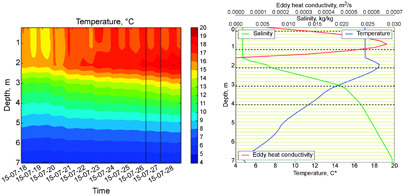The mid-depth temperature maximum (TeM) was measured in an estuarine Bol'shoi Vilyui Lake (Kamchatka peninsula, Russia) in summer 2015. We applied 1D k–ε model LAKE to the case, and found it successfully simulating the phenomenon. We argue that the main prerequisite for mid-depth TeM development is a salinity increase below the freshwater mixed layer, sharp enough in order to increase the temperature with depth not to cause convective mixing and double diffusion there. Given that this condition is satisfied, the TeM magnitude is controlled by physical factors which we identified as: radiation absorption below the mixed layer, mixed-layer temperature dynamics, vertical heat conduction and water-sediments heat exchange. In addition to these, we formulate the mechanism of temperature maximum 'pumping', resulting from the phase shift between diurnal cycles of mixed-layer depth and temperature maximum magnitude. Based on the LAKE model results we quantify the contribution of the above listed mechanisms and find their individual significance highly sensitive to water turbidity. Relying on physical mechanisms identified we define environmental conditions favouring the summertime TeM development in salinity-stratified lakes as: small-mixed layer depth (roughly, ~< 2 m), transparent water, daytime maximum of wind and cloudless weather. We exemplify the effect of mixed-layer depth on TeM by a set of selected lakes.
 Ссылка на публикацию
Ссылка на публикацию
V. Stepanenko, I. A. Repina, A. Artamonov et al. Mid-depth temperature maximum in an estuarine lake. Environmental Research Letters. — 2018. — Vol. 13, no. 3. — P. 35006.
News
RCC journal
Contacts
119991, Russian Federation, Moscow, GSP-1, Leninskie Gory, 1 , p. 4, RCC MSU
+7 495 939-5424,
Details
Recently added
Content of the RCC MSU website is licensed under:







